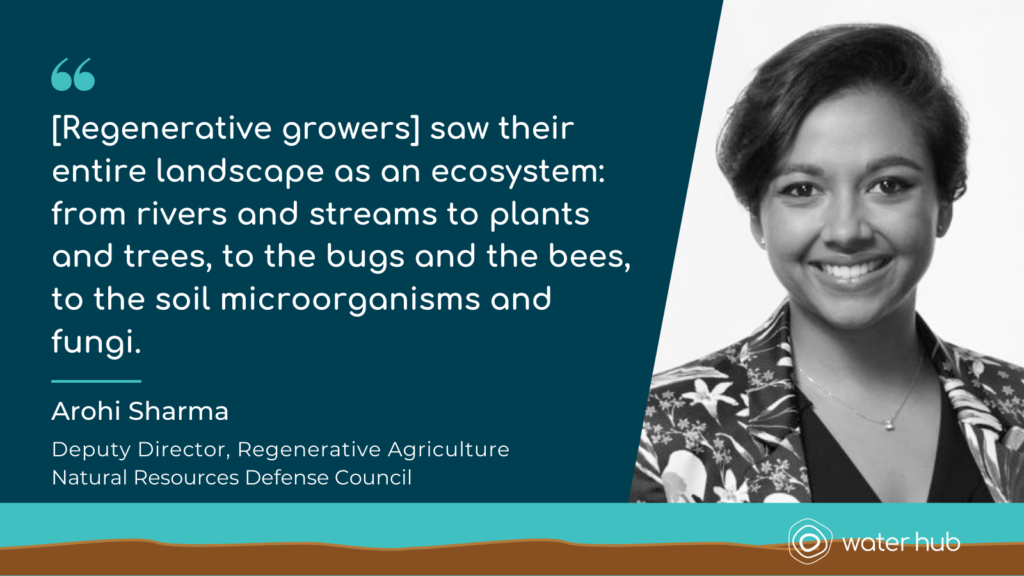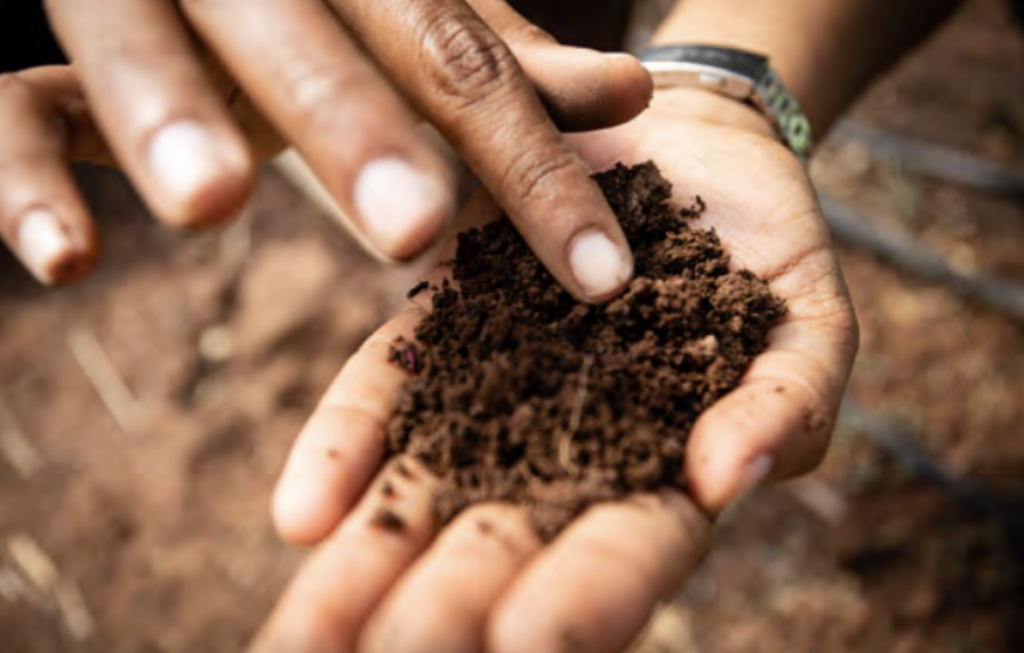Each month, we check in with advocates and organizers in California to talk about the water issues impacting local communities. We spoke with Arohi Sharma about why #SoilIsSexy, how soil health can be a tool for promoting water conservation and water efficiency, and the need for holistic policies that address the systematic structures of climate change.
Tell us a little bit about yourself and your role at NRDC?
Arohi Sharma: I am the Deputy Director of Regenerative Agriculture at the Natural Resources Defense Council (NRDC). I’ve been with NRDC for about four and a half years. NRDC is an environmental non-profit organization that fights to protect our environment, natural resources, and people and communities. We say we are ‘Earth’s best defense’ and embody that in [our] advocacy. My work focuses on how we can transition agriculture from being a contributor to climate change to fighting the climate crisis while building soil health to reduce greenhouse gas emissions, sequester carbon, and increase water conservation. That last point is especially important for my work to reduce agricultural water use and increase agricultural water use efficiency in California.
#California’s agriculture sector has been hit hard by the pandemic & continues being hit by effects of #ClimateChange like drought and wildfires. We need to make every part of our food system more resilient & healthier for everyone.
— NRDC ?? (@NRDC) February 23, 2022
Head to https://t.co/nNec9ZONRO to learn more! pic.twitter.com/VWghO9v3jl
What water issues are top of mind in your community right now?
The first issue that is always on top of my mind is soil health. It is my personal mission to get the hashtag #SoilIsSexy trending on Twitter (laughs). I’m always thinking about how soil health can be leveraged as a tool to increase water conservation and water efficiency, especially on agricultural lands. We’re in our third year of extreme drought in California; there is not enough water to sustain the status quo of agricultural production in this state. When it comes to water use and water conservation, how can we incorporate regenerative agriculture and soil health as a strategy to reduce agricultural water use? These two issues are deeply connected.
You recently released a new report, Regenerative Agriculture: Farm Policy for the 21st Century, where you interviewed more than 100 farmers in order to understand how we can shape our food system to better protect people and the planet. What are the main takeaways you want to share?
It was a blessing in disguise to structure the report the way we did. My team and I took a very grassroots approach to this report and talked with the folks doing the work on the ground to build a policy platform based on their lived experiences. That approach to our work is something more groups can and should be doing to inform the kinds of changes we need.
A key takeaway from our report is that regenerative agriculture is not new. The philosophy of regenerative agriculture, which is farming and ranching in harmony with nature and with communities, is a philosophy that Indigenous communities have upheld for millennia. The principles and practices of regenerative agriculture are all founded in Indigenous wisdom and that core component of the movement gets ignored, overlooked, and undervalued.

We spoke with 113 farmers and ranchers from 47 states and D.C. and it was shocking to us how many of our interviewees talked about the role that industrial agriculture plays in contributing to the climate crisis and how different parts of federal policies created barriers to scaling up alternative models of agriculture.
We learned how industrial agriculture is part of the climate problem and that regenerative ag is a part of the climate solution. The beautiful thing is there are people and communities already doing the work of regeneration; there are examples and leaders we can shine a spotlight on and uplift through policy.
The one thing that I personally took away after learning about regenerative ag was the systems mindset of regenerative growers. They saw their entire landscape as an ecosystem: from rivers and streams to plants and trees, to the bugs and the bees, to the soil microorganisms and fungi. But their understanding of regenerative agriculture didn’t stop there–regenerative growers also thought about the entire food system. They spoke about how all aspects of the food and agricultural supply chain need to be included in any conversation about scaling up regenerative agriculture, and that was a real eye-opening moment for me.

How do healthy soils protect or improve water quality?
We learned about all of the co-benefits that come from regenerative agriculture and building soil health. Not only do you sequester carbon, reduce emissions from topsoil, and help promote biodiversity above ground and within the soil microbiome, but you also see improvements in water quality up and down the watershed by building soil health.
When you build soil health the soil becomes spongier, which means that when water falls on it, instead of running off and contributing to nutrient pollution in waterways, the water trickles down into the soil and stays in the soil profile. This has huge water quality benefits because it means less water running off of a farm or ranch into a stream, a river, a pond, or a lake. When less water runs off there are fewer nutrients running off. Healthier soil means healthier water. Healthier soil means growers are also able to store more water on the land. More water stored on the land potentially means less water diverted from our already over-allocated water supplies. We can’t ignore how intimately water and soil are connected.
What do you wish the media and policymakers better understood about agriculture and climate change?
I wish more folks paid attention to the dual relationship between climate change and agriculture – industrial agriculture currently contributes to the climate crisis and climate change threatens agriculture. We’re seeing this in California: drought and extreme changes in temperature causing crop failures and climate change bringing new pest pressures and increasing wildfires.
I also wish policymakers knew how much power they have to change how things are done. I think there’s this fear of not wanting to change the status quo because it’s worked for some people in the past. The folks we interviewed are showing that an alternative model is possible, so I wish policymakers embraced this movement for change and really looked at how systemic changes in policy can help spur transitions toward alternative models of agriculture that are more beneficial for people and the planet.
From reforming the Federal Crop Insurance Program to changing the way the federal government currently chooses to fund confined animal feeding operations (CAFOs), we heard growers talk about the need to change federal policy in a lot of ways. The overwhelming amount of federal government funding that goes to support industrial agriculture is antithetical to wanting to preserve natural resources and protect the environment, and using federal dollars to prop up industrial agriculture makes it difficult for regenerative agriculture to compete. All this to say, I want policymakers to embrace the power they have in changing our system of agriculture.
Are there any policies or campaigns you’re working on in California right now?
We all saw how COVID-19 disrupted and stressed our food system. During the pandemic, a group of organizations came together to advocate for investments that would rebuild California’s food and farming system to be more equitable, just, and climate-resilient. We quickly learned just how much of an appetite there was to advocate for system-wide change, so we created the Food and Farm Resilience Coalition. After a series of [virtual] roundtable discussions across the state, where we heard from different stakeholders about how they would want to see the food and farming system reformed to better meet the needs of their communities, the Coalition drafted a $3.1 billion dollar bond proposal to help fund those ideas.
The bond proposal was – still is – pretty revolutionary in that it shows how policy can tackle a bunch of issues at once and address problems systematically. The $3.1 billion dollar bond proposal tackles four areas of investment: regenerative and organic agriculture and soil health, farmworker health and safety, regional food economies, and healthy food infrastructure. While the bond didn’t pass out of the legislature, the Coalition and its 140+ supporter organizations were able to secure more than $1 billion dollars worth of investments in the projects detailed in our original bond proposal last year. It was an amazing victory and, again, goes to show what happens when you build policy campaigns from the ground up. We’re continuing this important advocacy this year and making sure California’s budget surplus funds projects that we think will help transform our food and farming system.
What other potentially overlooked policy opportunities are there in California?
The California Air Resources Control Board (CARB) has a mandate to update its Scoping Plan every 5 years. The Scoping Plan basically outlines how California will reduce our state’s greenhouse gas emissions to achieve our state’s carbon neutrality goal. Agricultural lands have been included in the last few Scoping Plans, but never enough to the point to fully utilize the sector’s climate mitigating potential. We’re unfortunately seeing this play out again with this year’s update to the Scoping Plan. I think there’s a huge opportunity for advocates to leverage CARB’s 2022 update to its Scoping Plan and lay out how the state can reduce emissions and increase carbon sequestration on agricultural lands. We need ambitious targets and ideas for California’s agricultural sector. I’m working with several groups to draft a comment letter for the current comment period (which closes on June 24, 2022), and I know we can always use more support.
I know folks reading this care deeply about water conservation, efficiency, and quality. If we can convince CARB to care more about the climate mitigation potential of agricultural lands and invest heavily in building soil health through regenerative agriculture, we help build the kind of spongier soil that makes farmers and ranchers less reliant on dwindling surface water supplies.
Beyond CARB, what I need help with from other advocates, from people who care about water, is pushing state agencies to think creatively about how soil health can achieve a variety of goals. From better air and water quality to improved biodiversity and resilience to climate change, soil health should be leveraged more as a tool.
What is your happy place?
Beyond CARB, what I need help with from other advocates, from people who care. My happy place is not a physical space, it’s a state of mind for me. I practice mixed martial arts, Muay Thai kickboxing, and Krav Maga. [Also] building my strength, power, and confidence at the gym always puts me in a good mood. Really, anytime I’m moving my body, whether at the gym or dancing, walking outside, stretching my body, or frolicin’ – I find that I’m in my happy place.
Sign up for the Water Hub’s newsletter for more stories from the heart of the water movement, more partner love, and access to upcoming trainings!